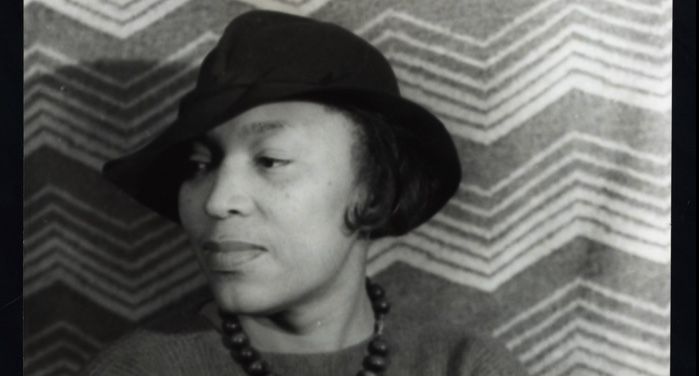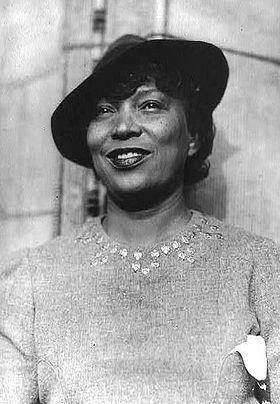
Zora Neale Hurston: Writer, Folklorist, Anthropologist, Activist
You may have heard of Zora Neale Hurston in your high school American Literature class when talking about the Harlem Renaissance. I’m sure Their Eyes Were Watching God came up at least once. Maybe you read Alice Walker’s article about her in Ms. magazine in 1975. Maybe you were like me and and knew one facet of her life, but then sat down in an anthropological theory class and were shocked to see a lecture built around her. Hurston has fortunately reentered the public view as an author and significant historical figure, especially as a Black woman. She was one of the most successful and significant Black woman writers of the first half of the 20th century. Yet she died penniless and buried in an unmarked grave until Alice Walker, who wrote The Color Purple, hunted down the author that was an inspiration.
Hurston was more than just an author, though. She was an anthropologist, an author, a filmmaker, a Black woman who pushed to be more and sought to bring community issues into the light with better understanding. She knew how to make an entrance, and you can feel the charm she must have exuded just looking at pictures of her, the hat she wears tilted at a jaunty angle, a gleeful grin and twinkling eyes, she looks like someone who has a story to share. And she did, several of them.

Early Life and Education
“I have the nerve to walk my own way, however hard, in my search for reality, rather than climb upon the rattling wagon of wishful illusions.”
Zora Neale Hurston in a letter to Countee Cullen
Zora Neale Hurston was born in Alabama in 1891 and her family moved to Eatonville, Florida, when she was a toddler. Eatonville was one of the nation’s first incorporated black townships, and this would shape her view of the world around her for the rest of her life. Living there, she did not receive the same racial inferiority indoctrination that others in white-dominated communities would have. She would look to town hall and see Black men like her father working together to govern the town; to the church and see Black women working to create the school’s curriculum; to the village store and see the town’s elders sharing their worlds through stories. Her childhood was relatively good, sharing an eight-room house with her parents and seven siblings, occasionally fighting with her preacherly father who disliked her rambunctious spirit.
And then her mother died when she was 13 and her father remarried not too long after, to a woman that Hurston greatly disliked. From then on her father seemed to lose interest in his children and in money, and Hurston had to work menial jobs to help support her family and struggled to complete her schooling. She eventually joined a Gilbert and Sullivan traveling group as a maid to the lead actress. She was 26 when she resurfaced in Baltimore in 1917, still not having finished high school. She ended up dropping ten years off her life, saying she was born in 1901, in order to qualify for the free public schooling there. She would never add those years back on, always saying she was ten years younger than she actually was. Given her youthful appearance, it’s pretty easy to see how she was able to get away with it.
After graduating from high school in 1918, she moved on to Howard University, an HBCU (Historically Black Colleges and Universities), and was an early member of the black sorority Zeta Phi Beta as well as co-founding The Hilltop, the university’s student newspaper. While there, she wrote “John Redding Goes to Sea” which allowed her to join Alain Locke’s literary club. In 1925 she went to Barnard College of Columbia University after accepting a scholarship from them. She was their only Black student, and later their first Black graduate. There, she met Franz Boas (yes, Father of American Anthropology Franz Boas) and studied anthropology under him, performing ethnographic research alongside students like Ruth Benedict and Margaret Mead.
Her Anthropology
“Research is formalized curiosity. It is poking and prying with a purpose.”
Zora Neale Hurston, Dust Tracks on a Road (1942)
Hurston got her Bachelor’s in Anthropology in 1928, becoming the first Black female anthropologist. Her research focused on the Caribbean and the American South, immersing herself in the cultures and collecting their folklore, showing how the folklore contributed to the community’s identity. Her book Mules and Men is based on the folklore she collected from 1928 to 1932. Her research into Black communities in the American South highlighted their struggle, like when she researched lumber camps in north Florida and remarked upon a practice between white men and Black women that would later be referred to as “paramour rights.” Later, in 1952, she would cover the trial of Ruby McCollum, a case about said rights, helping bring the issue to light for a national audience. Hurston believed that McCollum’s testimony sounded like the beginning of the end for paramour rights.
She was the first anthropologist to collect information on vodoun and Black spiritual practices. She tracked conjure lore throughout the Southern United States and Caribbean, from Louisiana to Jamaica and later Haiti, where she is said to have photographed an actual zombie. She was allowed into rituals that other anthropologists (white ones) were not allowed to view because she actually respected the practices, meaning she got a truly accurate view of what the religious practices were actually like, and she wrote about her findings and experiences in her book Tell My Horse: Voodoo and Life in Haiti and Jamaica. Her research and background in anthropology heavily influenced her other literary works, all of them about Black experiences.
Literary Works and Life in Harlem
“They seemed to be staring at the dark, but their eyes were watching God.”
Zora Neale Hurston, Their Eyes Were Watching God (1937)
Hurston arrived in New York in 1925 as the Harlem Renaissance was at its peak and quickly made her name known, her short story “Spunk” winning second place at a literary awards dinner held by Opportunity magazine in May of that year, along with winning other awards and nominations at the dinner. She had just entered the scene, hadn’t even started at Barnard yet, and here she was making room for herself.
Not long after that she joined forces with other authors like Langston Hughes and Wallace Thurman to form a salon of black intellectuals and artists, and produced the literary magazine Fire!! that featured up-and-comers in the Harlem Renaissance, names like Aaron Douglas, Countee Cullen, and Gwendolyn Bennett. Zora actually coined their group name, digging at the white dominated world of literati. (Fire!! currently has a spiritual successor for Black speculative fiction called FIYAH, that you can learn more about on its website.)
The group, Zora especially, regularly came under criticism by other Black luminaries of the time. These luminaries wanted art and writing that uplifted the Black community, pushing back against anti-Black prejudices; in short, they wanted propaganda to help foster favor for the Black community. The group’s goal was to create a magazine that would allow Black creators to express themselves however they wanted. Hurston’s award-winning play Color Struck is a good representation of what was else you would find within the magazine. The play uses southern dialect — language that is still often viewed as uneducated — and southern culture to look at interracial color consciousness and sex across color lines. The magazine only had one issue, unfortunately, as the headquarters for the magazine burned down not long after the issue was published.
This did not stop Hurston, though. After this she started her anthropological studies and regularly published her work and folktales she had collected. Trying to work within the expectations of Boas and Charlotte Osgood Mason, a patron of many writers in the Harlem Renaissance, she unfortunately did not get to publish all of the folktales she had collected the way she wanted, in their original dialect and with few changes. However, a copy of her manuscript was found in the Smithsonian archives and was published in 2001, titled Every Tongue Got to Confess. During this time, in 1931, she also wrote Barracoon about Cudjoe Lewis, the last known individual to be brought to the United States on an illegal slave ship in 1860; it was finally published in 2018.
From there, Hurston began writing plays, believing that folklore should be dramatized. She had little success, one play leaving her $600 in debt. It wasn’t until 1937 that she wrote what is likely her most famous novel, Their Eyes Were Watching God. Her autobiography, Dust Tracks on a Road, was published in 1942, which earned her some recognition as she was later featured in Who’s Who in America, Current Biography, and Twentieth Century Authors.
Her work still stayed obscure for a very long time, though. Her use of Black dialect and the way she wrote some of her characters was not approved of by a lot of other writers, as mentioned before. Some contemporary writers considered her depictions to be caricatures, the dialect demeaning, all catered towards white audiences. Zora wrote like a folklorist and an anthropologist, keeping the speech patterns as close to the original speaker’s as possible. With so many looking toward advancement of the Black community, showing what they all could be, having these characters seemed like a step backward because of their own biases.
Hurston’s politics were divisive, too. In a time where so many Black contemporaries were communist and writing about left wing ideologies to help advance their communities, Zora was economically conservative, and was even concerned that the New Deal was detrimental to the Black community, causing them to be too reliant on the government and ceding too much power to politicians.
Death and Alice Walker’s Search for Zora Neale Hurston
“Let no Negro celebrity, no matter what financial condition they might be in at death, lie in inconspicuous forgetfulness. We must assume the responsibility of their graves being known and honored.”
Zora Neale Hurston, in a letter to W.E.B. Du Bois
In 1945, Zora Neale Hurston wrote a letter to W.E.B. Du Bois, proposing an idea for a cemetery in Florida for well-known Black creators to be buried in, even if they were in financial straights at the time of their death. Du Bois rejected the idea, citing logistic issues. Had the plan not been rejected, we likely wouldn’t have to search for the grave sites of some authors, like Alice Walker did for Zora’s.
Hurston suffered from financial and medical issues towards the end of her life, suffering a stroke and eventually dying, penniless, of hypertensive heart disease on January 28, 1960, at the age of 69. Her neighbors had to raise money so she could be buried, and were unable to raise enough to get a headstone.
Zora Neale Hurston was be buried in an unmarked grave in an overgrown, segregated cemetery until 1973. That is when Alice Walker and Charlotte D. Hunt tracked down the approximate location of her grave. Alice Walker commissioned a marker for Zora, the author that had inspired her own work. Zora’s grave stone now reads “ZORA NEALE HURSTON / A GENIUS OF THE SOUTH / NOVELIST FOLKLORIST / ANTHROPOLOGIST / 1901–1960.”
Hurston still got to claim that she was ten years younger, even in death.
Wondering where to get started with Zora Neale Hurston’s work? Start here. To learn more about Fire!! and other publications like it, check out this look at the literary magazines of the Harlem Renaissance.











